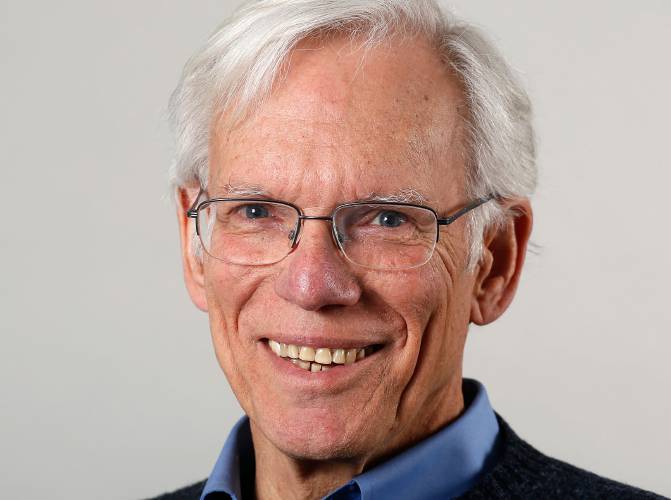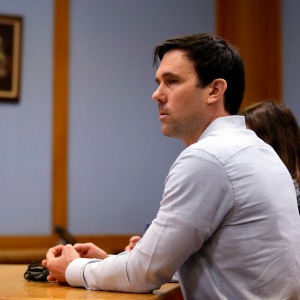Column: Public school equity is going to require more funding

Contributor Wayne Gersen in West Lebanon, N.H., on April 12, 2019. (Valley News - Geoff Hansen) Copyright Valley News. May not be reprinted or used online without permission. Send requests to permission@vnews.com.
| Published: 03-15-2024 5:26 PM |
Two recent Valley News’ editorials focused on what it called Vermont’s “education funding mess.” Vermont’s education funding is a mess, but a mess that is hardly unique to Vermont. It is not unlike New Hampshire’s “education funding mess” or the “education funding mess” in at least 12 other states where lawsuits seeking equity in school funding are pending.
It is also no different from the education funding mess I worked on while serving on a task force 30 years ago in Maryland when that state decided it was time to rethink its whole system of paying for public schools.
In 1993, Maryland Gov. William Donald Schaefer, facing potential lawsuits that challenged the existing funding formula as inequitable and unconstitutional, appointed a Commission on School Funding consisting of legislators from both parties and representatives from various stakeholder groups: teachers unions, School Board members, PTAs, school administrators, and the business community. The commission met monthly for nearly a year, reviewing scholarly articles, studies from various think tanks and testimony from experts on school funding. I represented the State Superintendent’s Association on the panel, offering our organization’s perspective and providing periodic updates to my colleagues on the commission’s deliberations.
After months of meetings and testimony, our commission issued a final report that recommended a new funding formula and the level of funding required to make the formula functional. The new formula was somewhat complicated because it took factors like the special education census, poverty levels and tax base disparities into account. But unlike Vermont’s current funding formula, which the Valley News characterized as “mind-numbingly complex,” our commission’s formula could be readily explained to school board members, the media and voters in plain language.
The ultimate problem with our commission’s report was political: Its cost was too high. To achieve equity without reducing the state funding of affluent districts from the pre-existing formula, the total pool of funds for public education needed to be increased substantially. It was clear to our commission that shifting funds from rich counties to poor ones was politically untenable so we emphasized the need for a larger pool of state revenue which, in all probability, would require higher taxes.
The commission’s report was not well received by the governor or the legislature. The governor accepted our recommended funding formula but ignored the funding level we recommended. When his lower budget figure was plugged into our formula, half of the districts lost state funding and half gained. Once these budget projections were made public, I was asked to survey my colleagues to get their reaction to the new funding formula. The results were predictable: Superintendents from districts that stood to lose money opposed the new formula and those from districts that would gain money supported it.
Ultimately the Legislature rejected the commission’s recommended funding formula and adopted a budget that used the existing one to distribute the governor’s recommended funding level. This avoided the problem of short-changing the affluent districts but did nothing to address the need for more equity.
Shortly thereafter, a Baltimore City parent filed a lawsuit seeking “the amount of funding necessary to provide a “thorough and efficient” education for public school students as Article 8 in the state constitution requires.” As of October 2023, that lawsuit remains unresolved.
Article continues after...
Yesterday's Most Read Articles
 Herd departs Hartford’s last remaining dairy farm
Herd departs Hartford’s last remaining dairy farm
 At Dartmouth, hundreds protest ongoing war in Gaza and express support for academic freedom
At Dartmouth, hundreds protest ongoing war in Gaza and express support for academic freedom
 Claremont removes former police officer accused of threats from city committees
Claremont removes former police officer accused of threats from city committees
 Over Easy: ‘A breakfast without a newspaper is a horse without a saddle’
Over Easy: ‘A breakfast without a newspaper is a horse without a saddle’
Whenever I read an article about “rethinking” school finance, the title of Loretta Lynn’s gospel tune, “Everybody Wants to Go to Heaven, But Nobody Wants to Die,” comes to mind. Public education supporters and parents want a heavenly world where every child can attend a high-quality school no matter where they were born. But that kind of ideal world can be attained only by redistributing existing tax dollars — which results in affluent districts losing state funding — or higher state taxes which all voters, including public education supporters and parents, are loath to accept.
I agree with the Valley News editorial’s conclusion that “it’s time to rethink the whole system.” Here’s advice from someone who spent a year working to overhaul a state system in the name of equity: It cannot be done without providing more state funding for public schools. The same advice applies to legislators in New Hampshire, Maryland, and every other state facing equity challenges. Any system that relies on property taxes as the primary source of funding will find itself in an equity bind since wealthier districts are able to raise far more for their schools than their less affluent counterparts and are able to do so with lower tax rates. State funds, distributed by a formula, can offset that imbalance.
A national examination of state school revenue portfolios over the first 20 years of this century conducted by the Shanker Institute found that on average 50% of all public school revenue comes from the state, with 42% coming from property taxes. In Vermont, which was one of four states not included in the Shanker study, the Valley News estimated that roughly 65% of the state’s revenue comes from property taxes. The Shanker analysis reported that in New Hampshire, 69% of the state’s revenue is drawn from property taxes, which ranked it 46th out of the 46 states analyzed. In Maryland, which ranked 31st, 54% of revenue for education is derived from property taxes.
The lawsuits seeking funding equity in New Hampshire, Vermont and Maryland were filed in the 1990s. For nearly three decades children in school districts lacking a strong tax base have not had the same learning opportunities as their peers in affluent school districts. Court orders haven’t provided relief, the legislators have not offered solutions and governors have not made the issue a priority. Indeed it is time to rethink the whole system of school funding. And, it is also time to realize that the problem of equity, which is driving that need, cannot be solved without providing more state funding. I look forward to reading about how this might be accomplished and may offer some ideas of my own.
Wayne Gersen is a retired school administrator. He lives in Etna.

 Editorial: Parker parole a reminder of how violence reshapes our lives
Editorial: Parker parole a reminder of how violence reshapes our lives Editorial: Chris Sununu’s moral vacuum
Editorial: Chris Sununu’s moral vacuum Editorial: Gambling tarnishes America’s sporting life
Editorial: Gambling tarnishes America’s sporting life By the Way: A white nationalist’s many mistruths
By the Way: A white nationalist’s many mistruths
